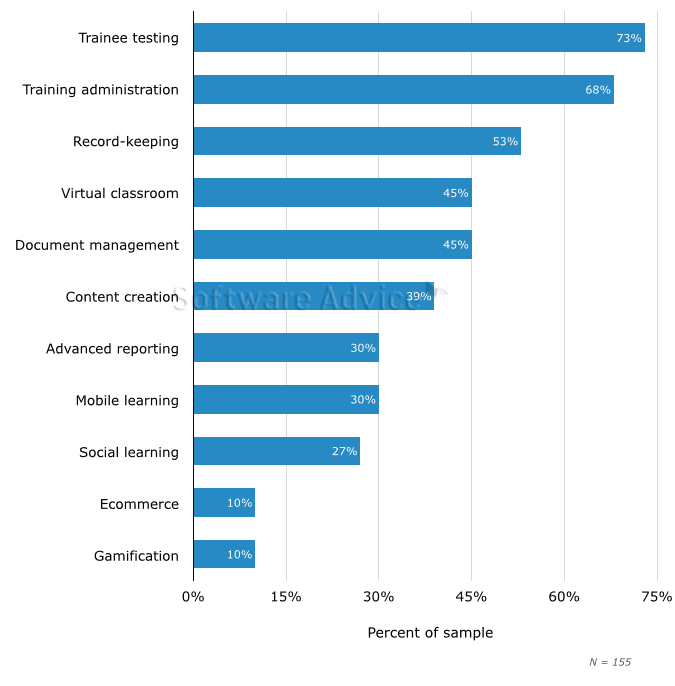One of the common uses for learning management systems (LMS) is to train and educate internal staff and employees within a business. Each organization has unique needs when seeking an LMS provider. Based on the latest report by training software research site Software Advice, we’ve rounded up a few key statistics on LMS investment plans, benefits, and challenges – as well as how DigitalChalk compares. Let’s take a look.

LMS Software positively impacts the organization of content and training efficiency for 99% of users surveyed.
When asked what functionality of their LMS software respondents use most, 73% say trainee testing, 68% say training administration and 53% say recordkeeping.
32% of users say integrating an LMS with other systems is a moderate to major challenge. Other moderate to major challenges include lack of customization (22%) and low user adoption (21%).
A large 89% of users still access their LMS from a desktop computer or laptop (76%) – and only 25% access their LMS from a tablet.
When asked about their future investment in LMS software, 90% say they are expecting to spend the same or more on their LMS in 2015.
How Does DigitalChalk Compare?
Finding the right LMS can be time-consuming and quite an investment. With DigitalChalk, you don’t have to worry about spending too much or not getting your necessary features. System integration is the number one LMS challenge, so it’s clear that many options are not as user-friendly or flexible as they should be. DigitalChalk has plenty of integration opportunities with our API – integrate easily with talent management systems, CRMs, Single Sign-On, back-office systems, and shopping carts.
Another challenge many LMS users noted is difficulty learning the system. You don’t have to worry about that with DigitalChalk – We have loads of video tutorials and blog articles to walk you through every step. In addition, we have a support team available whenever you need it.
Many LMS users claim that trainee testing, administration, and record-keeping are the most needed features. You’re in luck, because with DigitalChalk you can have all of those. Our built-in test feature automatically grades for you – and our tracking and reporting saves everything so you can easily export it as-needed.
Lastly, a large amount of LMS users are accessing the system via desktop or laptop computers. Although only a small amount is using their tablet or phone to access the LMS, you’ll have no problem with DigitalChalk. Access our LMS anywhere, anytime, 24/7.
Commentary
“LMS Software comparison site Software Advice conducted a survey of more than 150 HR professionals who use learning management system (LMS) software to learn how their organizations are using these systems for training, what benefits and challenges they’ve experienced and what their plans are for 2015. The results will inform potential LMS software buyers more about these systems to help them find an LMS system that works for them.
In terms of functionality, most often users say they use LMS software for trainee testing (73 percent), training administration (68 percent) and record-keeping (53 percent). These are common features in all systems, and align with the big three factors that influence companies to pursue an LMS platform, according to Mark Brandau at SuccessFactors: compliance-related training, talent development and external training for partners and customers.
Users say their LMS software is bringing a positive impact to training operation factors like organization of training content (99 percent), training efficiency (99 percent) and the ability to track learner progress (98 percent). The growth of Web-based LMS systems has also allowed organizations to reach a wider audience than ever before, according to Madeline Honig at CallidusCloud.
With any new software comes challenges, and LMS systems are no different. According to users, the biggest challenges that they are facing with their LMS software are integrating with other systems (cited as a “major” or “moderate” challenge by 32 percent) and a lack of customization (22 percent). This has led to a shift away from rigid on-premise systems to more customizable and accessible Web-based software.
What’s in store for 2015? Forty-five percent of respondents say they plan to increase LMS software investment this year, while another 45 percent say their investment will stay the same. Only 10 percent say they plan to decrease investment. The LMS market stands at over $2 billion, according to Forbes, and is going to continue to grow.
Overall, users are reporting immense satisfaction with their LMS system’s impact on their organization’s training—so much so, that nearly half are increasing their LMS investment this year. Potential buyers have a lot of options to choose from, and they should take careful consideration in analyzing needs, defining system requirements and vetting available products to find the right system for them.” – Brian Westfall, Market Research Associate at Software Advice
All data courtesy of Software Advice.




